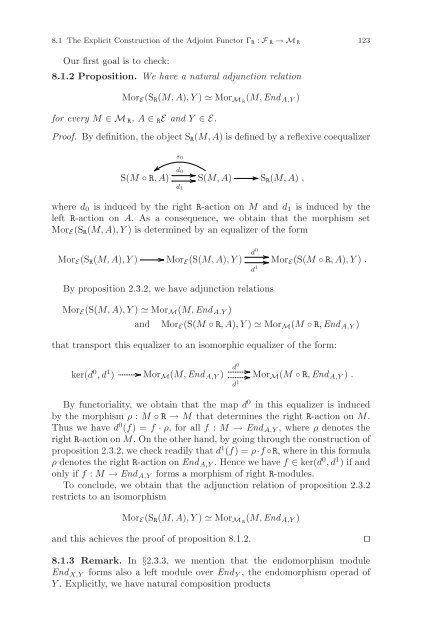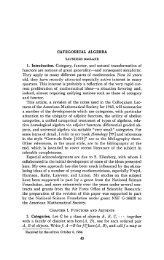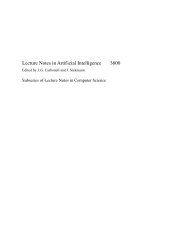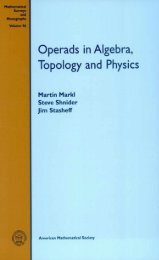Symmetric Monoidal Categories for Operads - Index of
Symmetric Monoidal Categories for Operads - Index of
Symmetric Monoidal Categories for Operads - Index of
You also want an ePaper? Increase the reach of your titles
YUMPU automatically turns print PDFs into web optimized ePapers that Google loves.
8.1 The Explicit Construction <strong>of</strong> the Adjoint Functor ΓR : F R →MR<br />
Our first goal is to check:<br />
8.1.2 Proposition. We have a natural adjunction relation<br />
MorE(SR(M,A),Y) � MorM R (M,End A,Y )<br />
<strong>for</strong> every M ∈MR, A ∈ RE and Y ∈E.<br />
Pro<strong>of</strong>. By definition, the object SR(M,A) is defined by a reflexive coequalizer<br />
s0<br />
S(M ◦ R,A) d0<br />
d1<br />
S(M,A)<br />
SR(M,A) ,<br />
where d0 is induced by the right R-action on M and d1 is induced by the<br />
left R-action on A. As a consequence, we obtain that the morphism set<br />
MorE(SR(M,A),Y) is determined by an equalizer <strong>of</strong> the <strong>for</strong>m<br />
MorE(SR(M,A),Y) MorE(S(M,A),Y)<br />
By proposition 2.3.2, we have adjunction relations<br />
MorE(S(M,A),Y) � MorM(M,End A,Y )<br />
d 0<br />
d 1<br />
123<br />
MorE(S(M ◦ R,A),Y) .<br />
and MorE(S(M ◦ R,A),Y) � MorM(M ◦ R, End A,Y )<br />
that transport this equalizer to an isomorphic equalizer <strong>of</strong> the <strong>for</strong>m:<br />
ker(d 0 ,d 1 ) MorM(M,End A,Y )<br />
d 0<br />
d 1<br />
MorM(M ◦ R, End A,Y ) .<br />
By functoriality, we obtain that the map d 0 in this equalizer is induced<br />
by the morphism ρ : M ◦ R → M that determines the right R-action on M.<br />
Thus we have d 0 (f) =f · ρ, <strong>for</strong> all f : M → End A,Y ,whereρ denotes the<br />
right R-action on M. On the other hand, by going through the construction <strong>of</strong><br />
proposition 2.3.2, we check readily that d 1 (f) =ρ·f ◦R, where in this <strong>for</strong>mula<br />
ρ denotes the right R-action on End A,Y . Hence we have f ∈ ker(d 0 ,d 1 )ifand<br />
only if f : M → End A,Y <strong>for</strong>ms a morphism <strong>of</strong> right R-modules.<br />
To conclude, we obtain that the adjunction relation <strong>of</strong> proposition 2.3.2<br />
restricts to an isomorphism<br />
MorE(SR(M,A),Y) � MorM R (M,End A,Y )<br />
and this achieves the pro<strong>of</strong> <strong>of</strong> proposition 8.1.2. ⊓⊔<br />
8.1.3 Remark. In §2.3.3, we mention that the endomorphism module<br />
End X,Y <strong>for</strong>ms also a left module over End Y , the endomorphism operad <strong>of</strong><br />
Y . Explicitly, we have natural composition products






